Santa Maria di Vallegloria Vecchia (ca. 1220)

This seems to have been the site of an ancient female hermitage. The sisters here were among the first to be incorporated into the Order of Poor Ladies of San Damiano, which Cardinal Ugolino (later Pope Gregory IX) formed in ca. 1220. Santa Maria di Vallegloria was named first after San Damiano in the letter that Cardinal Rinaldo (later Pope Alexander IV) sent to the 24 nunneries of this order in 1228, in which he announced his own appointment as their Cardinal Protector and the appointment of Brother Philip the Long as their Apostolic Visitor. In 1236, Gregory IX granted the nuns part of the properties of the nearby Abbazia di San Silvestro following its suppression;
There is evidence that St Clare had been instrumental in the formation of the nunnery at Santa Maria di Vallegloria:
-
✴Sister Balvina, who is documented as one of the early companions of St Clare at San Damiano, became the abbess (probably its first abbess) of Santa Maria di Vallegloria before she died in ca. 1240.
-
✴Sister Pacifica de Guelfuccio d’ Assisi, who gave the above information in her evidence in the process for the canonisation of St Clare, also testified that St Clare had sent her to spend a year at Santa Maria di Vallegloria, “to inform the sisters of that place”.
The Chronicles from Santa Maria di Vallegloria, which were probably written by Francesco Olorini in the 17th century, include the following (unreliable) information:
-
✴St Francis visited Santa Maria di Vallegloria in 1219, accompanied by other friars, including Brother Moricus of Spello;
-
✴following this visit, the Abbess Balvina d’ Offreduccio, who belonged to the Olorini family, decided to join the Order of Poor Ladies of San Damiano;
-
✴St Clare sent the Blessed Andrew Caccioli to reform the nuns at Santa Maria di Vallegloria, with Sister Pacifica in 1248, and he miraculously found a fresh water spring for the nuns; and
-
✴Blessed Andrew received the profession of Sister Cecilia di Gualtieri Cacciaguerra da Spello at Santa Maria di Vallegloria in 1250.
This information contains at least three cases of mistaken identities:
-
✴Abbess Balvina has been confused with another Sister Balvina at San Damiano, who died in 1254. She was a relative of St Clare and might well have been called Balvina d’ Offreduccio, although it is highly unlikely that she belonged to the Olorini family.
-
✴Sister Pacifica, whom St Clare sent to reform Santa Maria di Vallegloria, was still a nun at San Damiano when she gave evidence in the process for the canonisation of St Clare in 1253. The chronicles probably confuse her with another Sister Pacifica, who was Abbess of Santa Maria di Vallegloria in 1248-54.
-
✴Sister Cecilia di Gualtieri Cacciaguerra da Spello, who also gave evidence in the process for the canonisation of St Clare in 1253, said that she had joined the order three years after St Clare (ie. in ca. 1215 rather than in 1250).
(There are frescoes of “Beata” Cecilia and “Beata Pacifica” San Ventura).
The nuns of Santa Maria di Vallegloria enjoyed strong papal support after their erstwhile protector, Alexander IV became pope in 1254:
-
✴in 1256, he prohibited the building of new nunneries in Spello because this would prejudice Santa Maria di Vallegloria;
-
✴in 1258, he issued a bull that allowed the abbess to refuse to take in new nuns against her will; and
-
✴in the same year, he insisted that the reluctant Comune should give the nuns the building inside Spello “in the place where the Emperor Frederick II built a stronghold”, presumably to provide them with a place within Spello where they could collect alms and also take refuge in times of war. (This bull is the only surviving document referring to Frederick II as the builder of the so-called Cassero del Pianello).
Papal support was not, however, always forthcoming: in 1263, Pope Urban IV took the Benedictine nunnery of SS Giacomo e Margherita in Spello into papal protection, much to the disappointment of the nuns of Santa Maria di Vallegloria.
Pope John XXII authorised the nuns to move permanently to their site within the town walls in 1320 because of the threat of war with Assisi. The original nunnery is now abandoned and in ruins.
Santa Maria di Vallegloria (1320-38)
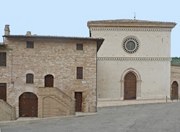
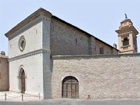
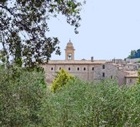
Ilaria (formerly Margherita), the daughter of Braccio Baglioni joined the community in ca. 1455 when she was only 11 years old, but she ran away to become a tertiary in the monastery of Sant' Antonio, Perugia some time after because of the laxity of the sisters. In 1477, a party of nuns were sent from Santa Maria di Monteluce, Perugia to reform the community.
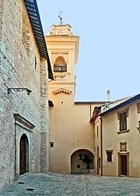
The nunnery was suppressed in 1866. The subsequent history of the complex is unclear, but the Poor Clares managed to return at some point.
Church
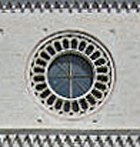
The church, which has a single nave, was also re-modeled in 1560.
[I have not yet managed to get into the church, but there are some interesting photographs of it on the website of Alessio Varisco.
Scenes from the life of the Virgin (1590)
These frescoes in the choir, which are signed by Ascensidonio Spacca, il Fantino and dated by inscription, depict:
-
✴the birth of the Virgin;
-
✴the Annunciation; and
-
✴the Visitation.
St Charles Borromeo in prayer (17th century)
This altarpiece on the right wall is attributed to Marcantonio Grecchi.
Frescoes on the counter-façade (17th century)
These frescoes, which are attributed to Marcantonio Grecchi, depict:
-
✴St Catherine of Alexandria and King David (partly covered by the choir); and
-
✴a fresco cycle above that originally had 18 scenes, 4 of which have been destroyed: those that survive largely depict scenes from the lives of the Virgin and of SS Francis and Clare.
Panels (17th century)
The following panels are attributed to Cesare Sermei:
-
✴the stigmatisation of St Francis (1627), on the left wall;
-
✴the triumph of Christian mortification, also on the left wall; and
-
✴a miracle of the Blessed Pacifica (one of the first nuns at Vallegloria), on the right wall.
Nuns’ Chapel
The chapel is to the left of the church.
Christus Triumphans (ca. 1228)
The nuns presumably brought this Romanesque Crucifix with them when they moved here from Vallegloria Vecchio.
Art from the Church
Crucifixion (15th century)

The altarpiece is now in the Pinacoteca Comunale.







